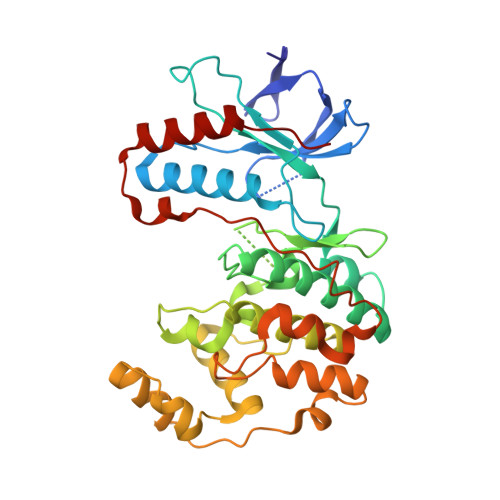Analysis of imatinib and sorafenib binding to p38alpha compared with c-Abl and b-Raf provides structural insights for understanding the selectivity of inhibitors targeting the DFG-out form of protein kinases.
Namboodiri, H.V., Bukhtiyarova, M., Ramcharan, J., Karpusas, M., Lee, Y., Springman, E.B.(2010) Biochemistry 49: 3611-3618
- PubMed: 20337484
- DOI: https://doi.org/10.1021/bi100070r
- Primary Citation of Related Structures:
3HEC, 3HEG - PubMed Abstract:
Protein kinases c-Abl, b-Raf, and p38alpha are recognized as important targets for therapeutic intervention. c-Abl and b-Raf are major targets of marketed oncology drugs Imatinib (Gleevec) and Sorafenib (Nexavar), respectively, and BIRB-796 is a p38alpha inhibitor that reached Phase II clinical trials. A shared feature of these drugs is the fact that they bind to the DFG-out forms of their kinase targets. Although the discovery of this class of kinase inhibitors has increased the level of emphasis on the design of DFG-out inhibitors, the structural determinants for their binding and stabilization of the DFG-out conformation remain unclear. To improve our understanding of these determinants, we determined cocrystal structures of Imatinib and Sorafenib with p38alpha. We also conducted a detailed analysis of Imatinib and Sorafenib binding to p38alpha in comparison with BIRB-796, including binding kinetics, binding interactions, the solvent accessible surface area (SASA) of the ligands, and stabilization of key structural elements of the protein upon ligand binding. Our results yield an improved understanding of the structural requirements for stabilizing the DFG-out form and a rationale for understanding the genesis of ligand selectivity among DFG-out inhibitors of protein kinases.
- Department of Biology, Locus Pharmaceuticals, Inc, Four Valley Square, 512 East Township Line Rd,Blue Bell, Pennsylvania 19422, USA. vnamboodiri@ansarisbio.com
Organizational Affiliation:

















